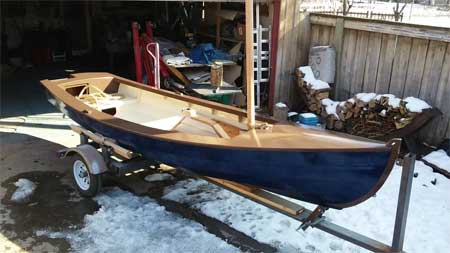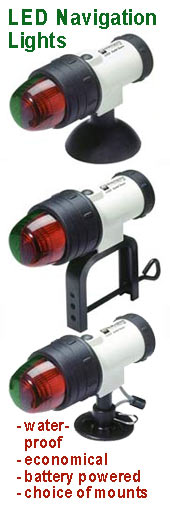Ain't That Purty... |
Just finished the design of a 4 man outrigger canoe for the Missouri 340 race. The sections look nice enough that I thought I’d share them as boat porn art.

|
Good Stuff |
Woodworker's Journal just had an article on the people currently behind the Adirondack Guide Boats. Not sure if it could run in Duckworks also, but if not, enjoy the story anyway. Here is a link to the article.

|
With a little help from my friends |
The first one:
First I ought to explain how this came to be. Playing baseball, and loving it as a youngster. When it came time to move up, because of age, I became a bench warmer. When introduced to surfing at about thirteen, I realized nobody would be telling me I had to sit on the beach. I ate it up for the next 40 years.
The natural progression would be sailing. At 18 given an opportunity for a trip to Catalina on a 32' engineless ketch, I signed on. What was to be an eight hour sail, one way, light winds dictated, two days there and two days back, actually we fell short, being towed into Redondo Beach Harbor late the second night after leaving Two Harbours, Catalina.
To say I was hooked on sailing would be an understatement. I had to have a boat; but where, how? I didn't have a clue. Build one?
I'd not had wood shop in high school, as most of my buddies had. The only carpenter among the relatives lived 100 miles north. There were no sailors in the family. The girlfriend's father who took us to Catalina was actually very unapproachable.
So, off to the marina with a cousin, on my brothers Honda 90. Somebody there, or nearby, surely could help. Redirected to Glen L Marine, supplier of boat plans and kits, I jumped in, both feet, hands and elbows and a head empty of any knowledge of what I was doing.
Being very supportive, my parents signed over the garage to me, amazing to me now. Some how it happened, it came together. When time came to start glueing parts, a friend stopped by, informed me I needed more glue, way more glue. Thank you Bob.
When came time to bend the plywood around the transom, the plans said: use hot water and towels, let it soak for a bit, before bending the ply.
Well, with the hot water heater being inside the house, pop directed me to bringing in the garden hose, mom said use the stove top with pans if you need more hot water. Crazy, TVs going, dad's reading, five brothers and three sisters, doing various things, everybody willing to lend a hand if needed. Truly wonderful. And help they did, bringing me hot water to pour on the towel soaked plywood as I tightened the Spanish windlass.
The mast arrived as one 4x6x24 feet, solid spruce from Hull Lumber Co. out of Willmington, long out of business. Spoke shave and hand planes, piles of shavings, day after day, my father came up with an idea to use templates as needed to check progress, I didn't have a clue. At the top it was about 2"x3".
I also didn't have a clue as to how I was going to get the sail track formed into the aft edge of the mast. Well, back to high school shop, even though I'd never had it when in school, the shop teacher listened to my predicament and says bring the mast on in, he had an idea.
Hope rises early and with a 24' long stick strapped along side an old beater of a car, hoping also the police are elsewhere, I swing into the parking lot next to the wood shop class, Mr. Williams has the class stand by after first having them lend a hand off loading the mast, not just one class but three, 'Stand by and learn something' he tells them, 'Where's my spot I'm thinking'. Mr. Williams worked his magic reshaping a router bit he had told me to pick up, set it in the router and showed his stuff to a bunch of boys, me included, thanks again Mr Williams.
Launching day came, and all the family and a few neighbors that could be were there as well. Lessons were about to come fast and furious. It's probably a good thing being naive, ignorant, young and full of zest, because when it comes, you just roll with it.
The boat was a 12' catamaran, El Gato, built per specs! Almost. The curve began very quickly, first to go was the starboard tiller. "Better head back", I tell friend Mark, "get up on the bows and be ready to fend off". Pumping the remaining tiller approaching dock it decides to join its buddy. Never even gave a thought to easing the main sheet, picking up speed, the bow man, try as he may, couldn't do a thing; well actually he did very well getting out of the way of the falling mast, full sail, Saturday, a full crowd. When the plans call for stainless, use it.
First sail, first boat, at times I think , things are pretty much the same fifty years on. Years and years have past and one thing my Father always remembered is some gal saying "Do always come in this way"
Michael J Beebe |
DuckyPoxy question |
Hello:
I have used West Epoxy for years but am very interested in the new Duckypoxy. I would use it for all the typical boat building applications but can it be used as a potting epoxy. If the exotherm is so low will it cure without overheating? Could you pot bugs or electronics in it? Is it as good for laminating? Wet out? Fiberglas Kevlar and Carbon?
I have enjoyed your site for many years. Thank you for all the great information you have passed along.
cheers,
joel
Joel: I am sure you could use our DWX (formerly Duckypoxy) for potting - I have only potted one chip brush (see below), but you might want to use a vaccum pump to get the bubbles out. We have definitely tested it for laminating and wet-out of fabrics and it works great. You can mix any additive such as silica, wood flour, graphite, etc too. - Chuck

|
Awesome |
You guys are AWESOME! Here's a picture of what you guys have helped me build. So Close!

My two dream boats have been either a Vivier Ilur or the Phoenix III. When Ross published the "how to" article in Wooden Boats, my decision was made. I was not against purchasing plans, but really liked the challenge of going at it from an article. Without the benefit of plans, I am sure it is not perfectly accurate, though his article was great. I also made some modifications of my own, mostly in the interests of single handed camp-sailing. I added water tight thwart tanks for more storage and tweaked the seat dimensions slightly so I could cover the front cockpit with removable decks. These can be repositioned to the rear in any configuration to either give me side benches or fill the entire rear cockpit for sleeping. When they are installed forward, they lock down keeping my gear from falling out in the event of a capsize and also keep the area clear and uncluttered. I saw similar storage/decking on Kurylko's Alaska and thought it smart and practical. The two innermost ones can also be removed to make a camp table. I also will raise the centerboard with a simple line through a sheave (my last order) to cleat instead of the rod in the plans. I like that it will be infinitely adjustable and seems easier to operate from the cockpit. All lines are also run back through sheaves I built into the mast partner so everything is at hand. I hope to launch it over Spring Break (I am a teacher) and will take it for a month this summer to explore Georgian Bay on Lake Huron.
When it is done and completed I feel that I need to write up a short bit on its construction for the benefit of others thinking of building it, give Ross credit for such a great boat, and send him some gratitude money. I cannot believe how gracious he was to put his design up for the masses in a magazine and he should be repaid in both promotion and money.
Thanks for your interest,
Marty |
Sailing Papparazzi |
|
Chuck and Mike,
I thought you might get a good laugh out of this. I went sailing at Elephant Butte Lake here in New Mexico on Saturday with my little worn out puddle duck. It was a poker run and I thought most of the sailing club was going to be there. It turned out that most of the people that showed up were all kayakers, nothing wrong with that mind you.
There was one other person that sailed. I'm not sure what the boat was, some production fiberglass boat that only handled one person. Unfortunately I forgot my camera so didn't get any pictures. His boat was shaped like a fat triangle with a wide stern. Just as I was sailing back in at the end of the day, he was trying to sail out, had some trouble with his dagger board, and turtled. I was impressed that after some struggling, he was able to get the boat back upright and get back in. Since it was at the end of the day, I think he was about as tired as I was. It took him about a good ten or fifteen minutes with help from one of the kayakers to get the boat righted and get back in. And the water was about 42 degrees.
However, the funny part was that as I was trying to sail back in to the cove where we started, the wind was against me and slowly building. It was quite a slog getting back. Maybe someday I'll get better at sailing. As I made the final turn into the cove and was having trouble hanging onto the sheet and the tiller because my hands were tired and sore, there was a fishing boat that came trolling into the cove behind me.
I didn't pay too much attention at first because I thought they were headed for a camping spot at the end of the cove. As they started coming around me I noticed a woman on the boat had a camera with a giant lens pointed at me.
She gave me a little thumbs up, I guess wanting to know if it was ok to take photos or film me. I gave her a thumbs up back and prayed I didn't capsize the boat while they were filming. It was getting to be all I could do to hang on and the boat was sort of bouncing along and splashing waves up over the bow.
The couple proceeded to go on around me very slowly, turned and headed back out of the cove. I have no idea who the people were or if the photos/film was just for their own benefit or if they plan on posting it somewhere. But I have never experienced anyone trying to photograph me as I was sailing before that wasn't part of my family, either immediate family or fellow sailors. It was a very odd feeling. They were probably filming because they had never seen anyone sail a box before.
Paul Cook
Las Cruces
|
Skiff Building class |
The Farley Boat Works is offering an opportunity to build the Port Aransas skiff in just two weeks (10 working days). This class allows you, the builder, to complete a 16′ long x 5′ beam, tiller operated outboard skiff designed for inland and coastal waters. This versatile little skiff is capable of planning with as little as a 15-hp motor. Theses skiff are built with okoume marine plywood. The kit includes everything except primer and paint. We will be building at the Farley Boat Works where all tools will be provided. Builders are encouraged to bring family and friends to help. At the end of class the student builder will take home a completed hull ready for sanding and painting. The builder will need to provide a trailer to take the boat home at the end of the class.
Dates: April 19-30, 2016
Time: 8:00 a.m. to 5:00 p.m., Tuesdays thru Saturdays
Instructor: Frank Coletta and Farley Boat Works crew
Class size: Space limited to 2 boats
Class Fee: $3995
Deadline for registration: March 19, 2016
Deposit: $1000 upon registration with balance ($2995) due on or before first day of class
For more details and registration go to www.portaransasmuseum.org.
Class location: Farley Boat Works, 716 West Avenue C, Port Aransas, TX
For more information call Frank Coletta at (210) 218-9961. |
Raising and Lowering |
Raising and lowering your mast, standard of living, or, call it downsizing. Bridges need to be gotten under if we're to sail the other side. Applied to life: if we've the forsight to see upcoming bridges, and they are clearly marked with a bit of attention.
Gin poles, blocks, tackles, lines: all set up and at the ready, with the knowledge to use and implement, should get us to the other side, continuing the cruise. This readiness, seamanship, also make the unforeseen much more manageable. A lowering of living standard ahead of finical storms could very well be the means by which we emerge on the other side still floating.
As in lowering the mast being but a temporary amount of time, there is still work involved, crew to be taught, things to be looked after. The game of baseball, said my grandfather who once played major league ball, will teach a person a lot about life. To a ten year old, such knowledge went over my head like a fly ball. Years later I realized my grandfathers wisdom, "If the ball comes to you, where are you going to do with it?"
Get ready, the next bridge is just around the bend. What's the situation? The surrounding terrain, wind blocking bluffs, trees, Pirates! Man the guns! Dismasting, ugh! The unforeseen breakage of good old wear and tear. What to do?
Sailing my 27' sloop, solo, out through the Long Beach break water of Southern California, the chop and congestion being about normal, various boats, pleasure and commercial, coupled with the ship being brought in by two tugs, I lost a spreader. Fortunately on the leeward side, no immediate danger, I had some time, a little. But now upon going through the passage of the breakwater channel, I was also on a lee shore, the breakwater itself.
Only habit got me through this one. The upper shroud useless, the lower still good, the chop was such it rendered the out board inoperable until I got back inside due to cavitation of the prop. Lashing the tiller kept me on safe course, allowing me to go forward to drop the foresail, secure it, takes its halyard back to the problem stay's chain plate, secure it there and apply as much tension as possible, all the while considering the mayhem that could be let loose at any moment.
Jury rigged, jib down, come about with enough space before incoming ship, knowing if I missed this one, I'd be on the rocks. It worked , it held, and back inside, out of the mix, I was able to lower the mainsail and continue back with the out board.
What got me through? God's grace, actually. It could have all comedown despite any of my actions. Sometimes it's just out of our hands, seamanship kept me busy, doing the necessary things, but I was in another's hands. We often read of the 'three event thing'. One failure leads to two more, which leads to loss of ship. I was looking at far more than two.
The unforeseen problems in life are just dealt with when they happen, to continue blissfully in denial when fore sight can be used is downright stupid. To paraphrase: A prudent person sees danger coming and hides himself, but the naive keep right on going and suffer for it.
Michael Beebe |
|
To comment on Duckworks articles, please visit one of the following:
|
|










